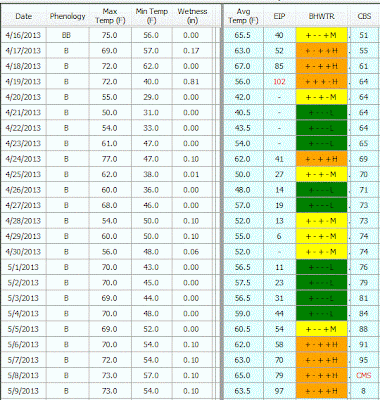We recorded our third apple scab infection period Apr 29-30, with 18 hr wetting at 50-56°. This was also a likely quince rust and cedar-apple rust infection period.
FIRE BLIGHT: Below is the updated graphic from the Maryblyt 7 program. Based on 9-day predicted temperatures and wetting, the risk column shows the fire blight infection risk history through Apr 30 and predicted risk through May 9. The next four days, May 1-4, illustrate that the EIP (epiphytic infection potential) can gradually increase although the average daily temperature is lower than the of 60°F required minumum for infection to occur. This is because the EIP is based on estimated degree hours that the temperature is above 65°F throughout the day. Based on predicted temperatures, the EIP will approach the required threshold of 100 later next week (97% on May 9). Most cultivars are still near full bloom and some susceptible bloom will likely be present and should be protected if those conditions occur. The CBS column at the right in the graphic indicates progression toward the appearance of canker blight symptoms on new growth, due to extension of overwintering cankers from last year, with canker margin symptoms (CMS) by May 8. Canker advancement will not be prevented by a chemical treatment and the presence of symptoms will indicate a build-up of inoculum which could become a factor in the event of a trauma blight situation due to hail injury, etc.
CAUTION: As usual, be aware that risks can change quickly with unpredicted warmer temperatures and wetting. In high-risk situations, a protective streptomycin application is recommended ahead of predicted infection. The weather conditions used in the predictive part of this graphic come from the Weather Channel for Winchester, supplemented by site-specific data from SkyBit Inc.
Disease management information directed mostly to the Frederick County Virginia tree fruit industry, updated as needed throughout the growing season. Keith Yoder, Virginia Tech Agricultural Research and Extension Center, Winchester, Virginia
Blog Archive
-
▼
2013
(36)
-
▼
May
(12)
- Accumulated wetting hours for the sooty blotch/fly...
- Scab and rust infection period May 23-24
- Recent infection periods
- Fire blight alert-Take care of newly planted trees
- Fire blight threat to late bloom wherever wetting ...
- Apple scab and rust infection period May 10-11
- Appearance of apple scab, cedar rust and fire blig...
- Disease update May 9; threat of fire blight throug...
- Heavy scab and rust infection period in progress M...
- Fire blight outlook
- Fire blight risk remains low. Have a great Shenand...
- Apple scab/rust infection period Apr 29-30, and fi...
-
▼
May
(12)
About Me

- Keith Yoder
- Professor Emeritus of Plant Pathology, Virginia Tech Ag. Research and Extension Center, Winchester, VA
